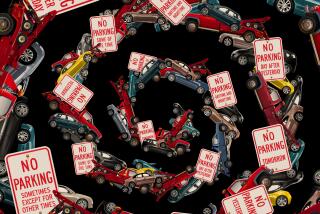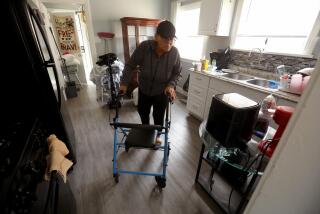Atlanta storm traffic like zombie movie, driver stuck 22 hours says
Samantha Avers didn’t think the drive would be so bad.
The 30-year-old account manager had been living in the Atlanta area for three weeks, enjoying its rolling hills and generally warm winter weather -- at least compared with the winters she’d spent in northern Virginia.
Up north, it seemed like snowplows would roll out at the first sign of trouble, she said. “So we had this false sense of security.”
So when the snow began to fall midday Tuesday in Atlanta, she wasn’t worried.
Of course, in the beginning, nobody knew how bad things would get in Atlanta. Not the governor. Not some of the schools. Not many of the drivers. And certainly not Avers: When she left Duluth, a suburb in northeast Atlanta, it was 1:30 p.m.
“I’m used to it, I’m a Midwesterner, this is no big deal,” thought Avers, who grew up in Ohio.
Twenty-two hours later, she would arrive at her home in Smyrna, about 25 miles away, a drive that, under ideal circumstances, would take about 30 to 45 minutes.
Avers’ story, told to the Los Angeles Times in a phone interview, is one shared by probably thousands of drivers across the South, where a fast-moving winter storm brought daily routines to a halt.
In Atlanta, one of the epicenters of the traffic disaster that ensued, police reported about 800 accidents as drivers lost control of their cars and in many cases abandoned them altogether. Statewide, police logged nearly 1,400 wrecks, with at least one person reported dead and at least 130 injured.
Icy, traffic-packed commutes of six to 12 hours were common. Many drivers took shelter in local stores or even slept on the roads in freezing temperatures.
Avers said she first tried to take I-85, which was clogged with traffic. Then her GPS told her she could save an hour if she got off the freeway and took the streets.
That’s when things started icing over. And all the detours involved tall hills. Her rear-wheel-drive BMW got stuck and a guy helped her out.
She took a bathroom break at a Walgreens. She got back on the road and thought she’d get on I-285, a freeway about a mile and a half away.
She thought traveling the 1.5 miles to the freeway would take a couple of minutes.
“Five hours later, I’m 1.4 miles away,” Avers said.
She was running low on gas, so she got gas. She got stuck again. Then, she said, a guy with a big truck pulled up to help her out.
“You got tow hooks?” he asked.
“I don’t think this Bimmer has tow hooks,” she replied.
Then a group of 10 guys helped push her free, she said.
What does a driver do when she’s stuck and going nowhere?
“In that five-hour period, I saw a bunch of signs for liquor,” Avers said, but she couldn’t find a bar where she could wait out the traffic. “So I finally walked to gas station and got a deuce-deuce [a 22-ounce beer] and poured it in a coffee cup. This isn’t drinking and driving if I’m not going anywhere.”
At 11 p.m., Avers said, she finally made it to the freeway -- and the scene was like something out of a zombie movie.
Abandoned cars. Jack-knifed tractor-trailer trucks. Forlorn drivers, out of gas or out of hope, walking along the side of the road. Tires skidding on ice without moving their drivers forward.
“You see weird breaks where it’s like a graveyard for dead trucks,” she said. “It’s like ‘The Walking Dead.’”
Avers’ husband, Aaron, a chef who had left work at 10 p.m., was stuck in traffic two or three miles behind her.
“Meanwhile my father is calling me every hour, on the hour, from Ohio, and he’s like, ‘Are you OK?’ and I’m like, ‘Dad, I’ve literally traveled two-tenths of a mile since we last talked.’”
And Avers had not even reached what she had called “the real stopping point” yet.
That was two miles from her exit, at 2 a.m. Nothing moved.
“I started watching ‘Private Practice’ on Netflix on my iPad,” Avers said. “So I’m watching my episodes, it turns into 3 o’clock, 4 o’clock, 5 o’clock, and we hadn’t moved in forever, and I’m about to run out of gas again.”
So she turned off the car. She was still wearing the suit she had on at work, but she piled other clothes in the car on herself. She noshed on the food and fruit in her Superman lunchbox, whose contents she thankfully hadn’t eaten at work.
And then she fell asleep in her car in the middle of the freeway.
“I closed my eyes, and I woke up because I’d think we were moving, and nobody was moving,” she said.
Finally, at 6 a.m., a police officer knocks on her window to tell her to move her car so a Georgia Department of Transportation truck can get through.
Avers was still wearing her nice work shoes, so she paid a guy to go get a can of gas for her car. After a 45-minute hike through the ice and snow, he returned with a can of gas and $3 in change.
“Are you kidding me?” she wondered. But then nothing about Atlanta’s traffic disaster was particularly normal for anybody involved.
“My sister’s freaking out, my family’s freaking out, everybody’s calling me every five minutes, and they’re like, ‘What are you doing?’ and I’m just like, ‘I’m sitting here,’” Avers said.
Finally, she got off the freeway. She couldn’t get home, but she got close enough. She parked at the edge of her neighborhood and walked into her home.
It was 11:30 a.m. She’d just made a 22-hour trip. Her husband arrived home after his own 12-hour trek, in a drive that usually takes him about an hour.
Avers decided to tell her boss that she probably wouldn’t be able to make it to work that day, or maybe the next day either.
Worst drive ever? Maybe. Avers says there were bright spots about her new city, even if it didn’t quite know how to drive.
“There were people -- I’ve never seen this before -- there were people in neighborhoods that were standing outside with water bottles, apples, food to give to people that were stuck; men that were out there, already home -- or not home -- guys that pulled over at the tops or bottoms of hills, pushing people out,” Avers said. “Three, four different times today I wouldn’t be able to get home without outright strangers helping me.
“And that,” she said, “was really amazing.”
More to Read
Sign up for Essential California
The most important California stories and recommendations in your inbox every morning.
You may occasionally receive promotional content from the Los Angeles Times.











